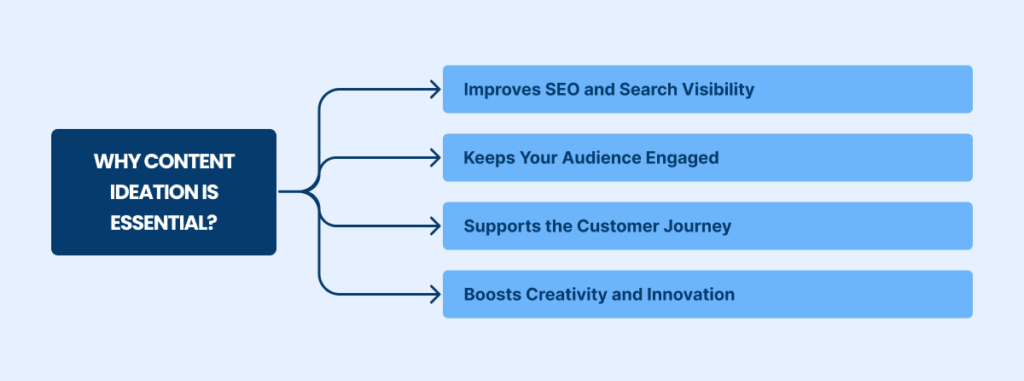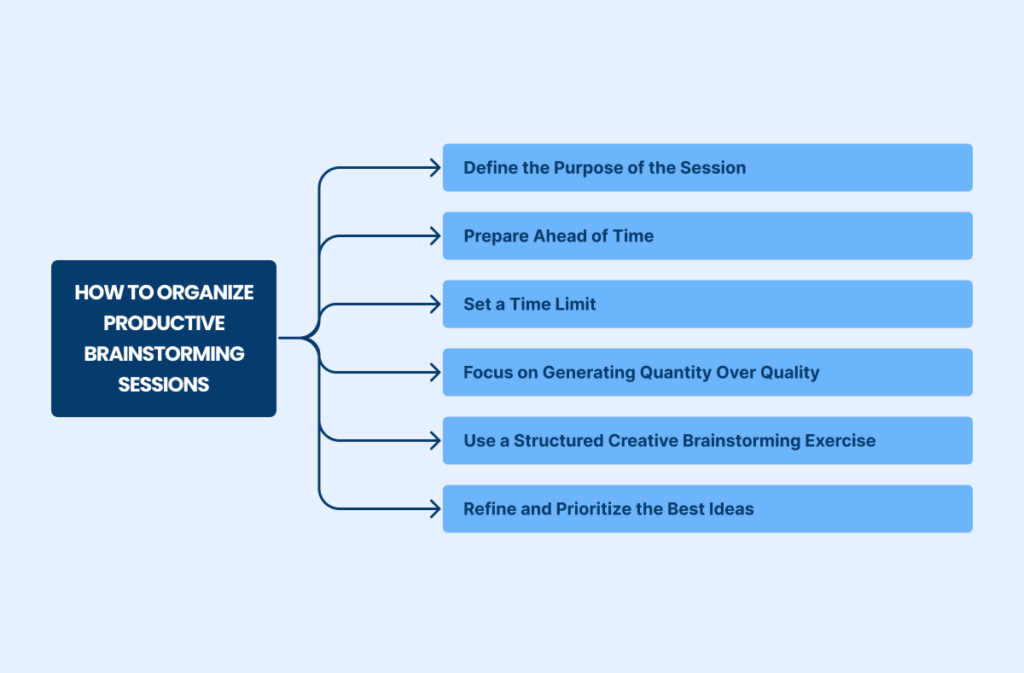The demand for fresh and engaging content is essential in today’s fast-paced digital world.
Generating innovative ideas doesn’t have to be so challenging. With the right approaches, you can effortlessly spark your creativity and consistently generate compelling content ideas.
Content ideation can be daunting, but it doesn’t have to be. You can spark your creativity and generate a steady stream of fresh ideas with the proper techniques.
74% of content marketers craft content based on specific customer journey stages.
Source: Content Marketing Institute
By aligning the content with each stage, from awareness to decision, you can deliver more personalized, relevant information that resonates with your audience, driving higher engagement and conversion rates.
Effective content ideation plays a vital role in this process.
Accordingly, a quality Content Marketing Agency can streamline the ideation process by conducting thorough audience research, analyzing data, and utilizing tools.
The blog post will cover content ideation using 15 productive techniques.
Why Content Ideation is Essential for Marketers
In the fast-paced world of digital marketing, producing engaging and valuable content consistently is a major challenge.
In 2024, the content marketing industry will grow to be worth an estimated $600 billion.
Source: Forbes
This is where content ideation becomes essential for marketers.
It’s generating fresh, relevant ideas that resonate with your target audience and align with your overall content strategy.
Without a strong ideation process, even the most experienced marketers can struggle to keep content flowing, negatively impacting your online presence, SEO performance, and engagement.
Benefits of Consistent Content Creation
Consistent content creation is vital for building brand authority, maintaining audience engagement, and improving search engine rankings.

Technique 1: Brainstorming Sessions
Brainstorming is one of the most fundamental and effective methods for content ideation. Whether you’re developing a new content strategy, seeking blog post ideas, or trying to refresh your marketing campaigns, brainstorming sessions can help you generate a wealth of fresh ideas.

A well-organized brainstorming session can foster creativity, innovation, and collaboration within your team, leading to new ideas that can elevate your content efforts.
A structured approach is crucial to making brainstorming as productive as possible. This not only encourages creativity but also ensures that your session leads to actionable outcomes rather than scattered concepts.
When done correctly, brainstorming can be a powerful tool to fuel your content guide and generate ideas for long-term campaigns.
Technique 2: Competitor Analysis
Analyzing your competitors’ content is one of the most effective ways to inspire content ideation and find gaps in your content strategy.
By understanding what works for others in your industry, you can generate new ideas, improve upon existing strategies, and identify opportunities to create content that sets your brand apart.
Competitor analysis involves examining the topics, formats and keywords your competitors are using, as well as how their content is performing. This approach allows you to learn from their successes and avoid their mistakes, helping you stay competitive and relevant in your niche.
Identifying Gaps in Competitor Content
One of the key benefits of competitor analysis is the ability to find gaps in their content that you can capitalize on. These gaps could be topics they haven’t covered, keywords they’re not targeting, or audience needs they haven’t addressed.
Filling these gaps provides an opportunity for your brand to offer something unique and valuable to your target audience.
1. Analyze Their Keyword Strategy
Using tools like Surfer Seo, you can analyze the keywords your competitors are ranking for and identify which ones they might have missed.
By understanding their keyword strategy, you can uncover content ideas around topics they aren’t addressing but are relevant to your audience. This allows you to rank for those keywords and attract more traffic.
2. Evaluate Content Depth
Competitors might touch on certain topics but fail to explore them in-depth. You can find opportunities to create long-form, comprehensive content on these subjects.
Tools like GPT Transformer can help you draft extensive, well-researched guides that go beyond what your competitors offer, improving your chances of ranking higher and attracting a more engaged audience.
3. Look for Unmet Audience Needs
Another approach is to analyze your competitor’s content through the lens of the customer persona. Are they addressing all the needs of their audience? Are there common questions that their content leaves unanswered?
Customer reviews, comments on blog posts, and feedback on social media can provide insights into what customers want but aren’t getting from competitors.
4. Leverage Visual Content and Formats
Often, competitors might not fully explore different content formats, such as videos, infographics, or podcasts. If your competitors are sticking to blog posts, for example, you could fill a gap by creating engaging video content using Heygen AI.
Videos are particularly effective for tutorials, product demos, or interviews with industry experts, and they can help you stand out from a sea of text-based content.
By regularly conducting competitor analysis, you ensure that your content ideation process is informed by both what’s working in the industry and what’s missing, allowing you to provide unique value to your audience.
Technique 3: Social Listening
Social listening is an invaluable tool for discovering what your target audience is talking about and identifying trending topics.
This technique involves monitoring social media platforms, online forums, and other digital communities to track conversations around your brand, industry, or relevant keywords.
By listening to what people are saying, you can uncover content ideas that address real-time concerns, questions, and interests.
With social listening, you better understand your audience’s preferences and pain points, which can directly inform your content guide and strategy.
Tools like Surfer Seo, Heygen AI, and GPT transformer can also help analyze the data collected from social listening, making it easier to generate content that resonates with your audience.
Technique 4: Customer Feedback and Surveys
Customer feedback and surveys are essential tools for content ideation because they allow you to directly tap into your target audience’s thoughts, needs, and preferences.

Understanding what your customers think helps you craft content that resonates with them on a deeper level, ensuring that your content remains relevant, engaging, and aligned with their needs.
While analyzing competitors and following trends are helpful strategies, no source of content inspiration is more reliable than your customers.
Feedback can guide your content ideation efforts by revealing gaps in your content, highlighting customer pain points, and suggesting topics of genuine interest to your audience.
Why Use Customer Feedback for Content Ideation?
Customer feedback provides direct insights into your audience’s challenges, questions, and desires.
When customers share their experiences with your products or services, they often reveal unmet needs or areas requiring further education or guidance. These insights are invaluable for generating content ideas that align with your audience’s concerns.
For example, if multiple customers mention struggling to use a particular product feature, you could create a how-to guide or an FAQ to address their concerns. If customers ask about broader industry trends, you could create thought leadership content to establish authority in that space.
Surveys allow you to ask your audience specific questions about their preferences and pain points. They help you understand what content formats and topics appeal to them most.
Incorporating survey feedback into your pillar and spoke strategy ensures that your content pillars (comprehensive guides or resources) and spokes (related pieces of content) are tailored to your audience’s needs.
Technique 5: Keyword Research
Keyword research is one of the most fundamental elements of content ideation. It provides a structured way to identify topics and phrases your target audience is actively searching for online.

By understanding what your audience is looking for, you can tailor your content to meet those needs, improve your website’s search engine optimization (SEO), and drive organic traffic.
Effective keyword research reveals high-traffic topics and offers insights into customer intent, helping you develop valuable and highly relevant content.
Targeting Long-Tail Keywords for Unique Ideas
Long-tail keywords are longer, more detailed search phrases with lower search volume but higher intent and lower competition.
While short-tail keywords might be broad, such as “content marketing,” a long-tail keyword would be more specific, like “how to create a content marketing plan for small businesses.” Although fewer people may search for these long-tail terms, those who do are often further along in their decision-making process and more likely to engage with your content.
Technique 6: Repurposing Existing Content
Repurposing existing content is one of the most effective ways to maximize the value of your content creation efforts.
Rather than constantly developing new content from scratch, repurposing allows you to breathe new life into your best-performing assets by transforming them into different formats.
This method saves time and resources and helps you reach different segments of your audience who may prefer various content formats.
Repurposing content is a core component of any sustainable content ideation strategy.
Technique 7: Google Search Suggestions
Google Search Suggestions, or Google Auto-Suggest, is a valuable yet often underutilized tool for content ideation.
Using Google’s search suggestion feature, you can discover real-time queries that users are actively searching for, which helps guide your content creation efforts toward relevant and timely topics.
Google Auto-Suggest is the feature that provides search term predictions as you start typing in the search bar.
These suggestions are based on popular searches related to your query, making them a goldmine for uncovering relevant topics and long-tail keywords that can inspire your next content piece.
Technique 8: Industry News and Trends
Staying up to date with industry news and trends is essential for keeping your content relevant, timely, and informative. Trends can change rapidly in the fast-evolving world of digital marketing, technology, and consumer behavior.
You can consistently monitor industry developments to ensure that your content remains fresh and competitive.
Incorporating industry news into your content ideation strategy also positions your brand as an authoritative voice in your niche.
Regularly covering trending topics can boost your SEO performance, attract new audiences, and keep your existing readers engaged with up-to-date information.
Technique 9: Case Studies and Success Stories
Case studies and success stories are powerful tools in any content ideation strategy. They provide real-world examples of how your product or service has helped customers overcome challenges and achieve their goals.
This type of content adds credibility to your brand by offering concrete evidence of your expertise and results.
Case studies and success stories resonate with potential clients and provide a template for various types of content, including blog posts, social media content, and even video testimonials.
Technique 10: Content Collaboration
Content collaboration is an effective way to generate fresh ideas, expand your reach, and bring new perspectives to your audience.
By partnering with other brands, influencers, or industry experts, you can co-create content that offers a unique blend of insights, making your content more valuable and engaging.
Collaborations also allow you to tap into your partners’ audiences, boosting visibility and driving traffic to your site. Whether you collaborate on blog posts, webinars, podcasts, or videos, exchanging ideas often leads to innovative and creative content.
Technique 11: Online Communities and Forums
Online communities and forums are excellent platforms for sourcing content ideation because they are filled with real people discussing real challenges, ideas, and trends.
Source: Reddit
Platforms like Reddit, Quora, and niche-specific forums provide a direct window into what your target audience is thinking, making them a goldmine for generating relevant content ideas.
Technique 12: Content Curation
Content curation is the process of gathering and sharing relevant, high-quality content created by others. It’s a great way to keep your audience informed while establishing yourself as a trusted source for industry insights.
Instead of constantly creating new content, you can share useful resources, articles, or tools from other thought leaders, providing value to your audience while saving time.
Technique 13: Use Content Generation Tools
In today’s fast-paced digital landscape, using content generation tools has become a crucial part of any content ideation strategy.
These tools can speed up the process of coming up with fresh content ideas, streamline the creation process, and ensure that your content is relevant to your audience.
Source: ChatGPT
One of the most powerful advancements in this space is the use of AI-driven tools for generating creative and insightful content ideas.
Technique 14: Seasonal and Holiday-Themed Content
Creating content that aligns with seasonal events, holidays, or special occasions is an effective way to engage your audience and tap into the existing excitement around those times of the year.
People are often in a particular mindset during holidays or special events, and creating content that resonates with those emotions can help your brand connect with your audience on a deeper level.
Technique 15: Storytelling and Personal Experiences
Storytelling has always been a powerful tool in content marketing. People are naturally drawn to stories, and incorporating personal experiences into your content can create an emotional connection with your audience.
Whether you’re writing a blog post, recording a podcast, or creating a video, sharing personal stories can make your content more relatable and engaging.
Partner with [A] Growth Agency for Enhancing Your Content Marketing Strategies
In today’s digital age, content marketing has become an indispensable tool.
Businesses are looking to connect with their audience, build brand awareness, and drive conversions.
[A] Growth Agency will take the responsibility. Our team specializes in turning entrepreneurial dreams into reality with effective, tailored growth strategies.
Moreover, we believe in the power of data to inform and drive every strategy, ensuring our actions are as effective as they are innovative.
We don’t just set goals — we build actionable roadmaps to achieve them.
This is not the whole we can offer.

